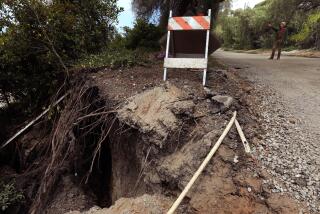The Calm Before Cleanup in Des Moines : Flooding: The city is ‘strangely quiet’ while residents wait for water to be restored. Then will come the massive chore of clearing away the muck.
Eleven days after severe flash-flooding knocked out power and running water here, the heart and soul of this city of 250,000 residents remained on a war footing Wednesday.
With the city’s water treatment plant and major electrical substations still mostly out of commission, 40,000 downtown workers remained on orders to stay home while crews tried to restore basic sanitation and safety services at major firms and City Hall.
Full service would not return until Monday, when city staffers and workers were expected to return to their offices, warehouses and industrial buildings to pick up the pieces after suffering untold millions of dollars in damage.
“It will take six months to get homes cleaned up, small businesses reopened, streets repaired and people fairly comfortable and safe again,” said Des Moines Mayor John Dorrian. “Then we’ll be gearing up for snowstorms and ice.”
Downtown economic activity has fallen off the charts. Major hotels and corporate centers were closed. Farm processing plants and meat packing companies were idle. Employers struggled to keep payrolls going.
“It’s quiet, strangely quiet,” Des Moines lawyer Jeff Krausman said after a brief visit to his office on the 20th floor of the downtown Financial Center. “It’s hard to have any emotion other than astonishment.”
It’s been that way since July 11 when flash-flooding along the Raccoon and Des Moines rivers--which merge downtown--lathered buildings and streets with a muddy, smelly mixture of sewage, fertilizer and toxic chemicals. The flooding severely damaged or destroyed 1,500 homes and 1,000 businesses.
Instantly, Des Moines’ resources shifted toward preserving its infrastructure and financial balance.
Now, the rivers are in retreat and the effort has turned toward the monumental job of hauling away thousands of tons of damaged belongings stacking up on suburban lawns, a million sandbags saturated with polluted water and mountains of flotsam and uprooted trees tossed aside by the flooding.
Downtown, utility crews are working hard to bail out flooded basements, get computer systems back on line, re-establish phone lines and rewire buildings evacuated before the electricity could be shut off. In some cases, office equipment literally cooked in the muck.
“There is some glamour in taking off your shirt and filling sandbags in front of television news cameras--but that’s over,” said Des Moines salesman Dennis Smith, 45. “Now, we’re down to the dirty work of reclaiming furniture from crud and mud. I wonder how many volunteers will turn out for that kind of work.”
A test of this city’s fortitude could come over the weekend, when city officials issue a final call for thousands of volunteers to participate in a massive cleanup effort.
Dorrian warned: “There are major problems, and bills, yet to come.
“The cleanup effort will be just as devastating as the flooding,” he said. “We still don’t have any idea of infrastructure damage. We do know, however, that the cost will be sky high.”
Des Moines City Manager Cy Carney said that the city learned an important lesson the hard way.
“The impact of losing a water treatment plant is beyond what anyone ever imagined,” Carney said. “A community must have a clear plan for a substitute source of drinking water in place--just in case--even if its water treatment plant is on the highest hill.”
Most residents here would agree. Water reached fire hydrants Wednesday night for the first time in 10 days. It was finally expected to begin flowing through city taps--one zone at a time--today after a week of stops and starts at the water treatment plant. The slow start-up was blamed on mechanical failures, leaking pipelines and “cheaters” who opened faucets before the system was fully charged.
“Our hope is that we’re going to get everybody back in water over the weekend,” said L.D. McMullen, executive director of the beleaguered water plant.
“Once the whole system is charged . . . , that will be a signal that business can resume at a reduced level,” he said. “We’re still going to ask that customers use 50% or less of the water they would normally consume.”
The long-awaited water would only be good for laundry, showers and flushing toilets. It would not be safe for drinking for at least another three weeks.
But like thousands of other families struggling through an unusually hot, soggy and calamitous summer here, 45-year-old salesman Tyrone Hunt, his wife and two children were happy to temporarily lower their standards.
Working faucets would mean no more standing in line at water distribution centers. No more hauling bucketfuls of water into the bathroom to flush the toilet. No more trips to crowded Laundromats.
“Like hemorrhoids, we won’t miss any of it,” Hunt said. “We’re probably going to crowd into the bathroom to enjoy the luxury of pulling a lever on the toilet and watching the water go down.”
More to Read
Sign up for Essential California
The most important California stories and recommendations in your inbox every morning.
You may occasionally receive promotional content from the Los Angeles Times.






